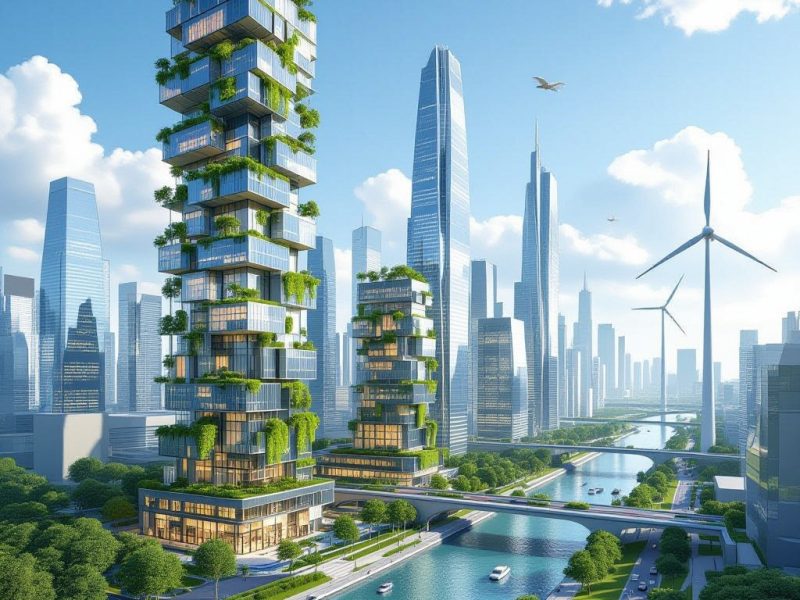Introduction: The Eco Awakening
2025 is shaping up to be a defining year for sustainability. Faced with the consequences of decades of industrial pollution, climate change, and resource depletion, humanity has finally hit the reset button. Eco-consciousness is no longer just a niche movement—it’s mainstream, urgent, and global. From urban planning to agriculture, from technology to fashion, eco-friendly innovations are blooming everywhere.
But what exactly is changing? What are the key innovations driving this green transformation? And how can individuals contribute meaningfully in their everyday lives? In this comprehensive guide, we’ll explore the sustainable shifts shaping our planet’s future.
1. Green Urban Planning: The Eco-City Revolution
Across the globe, cities are evolving from smog-filled concrete jungles to clean, green sanctuaries. Eco-cities like Singapore’s Tengah or China’s Xiong’an New Area showcase how technology, ecology, and urban design can harmoniously coexist.
- Vertical Gardens: Buildings are now covered in lush greenery, absorbing CO₂ and reducing urban heat islands.
- Smart Water Systems: Rainwater harvesting and gray water recycling are becoming standard in residential architecture.
- Pedestrian-First Planning: Walkable streets, bicycle lanes, and public transport zones dominate cityscapes.
The age of concrete domination is ending, giving way to living, breathing cities.
2. Renewable Energy Domination
By 2025, renewables are on the verge of overtaking fossil fuels globally. Solar, wind, and hydro innovations are expanding rapidly—becoming more efficient and affordable.
- Perovskite Solar Panels: These next-gen panels are cheaper, more flexible, and more efficient than traditional silicon-based panels.
- Floating Wind Farms: Offshore turbines on floating platforms are unlocking massive wind potential in deep seas.
- Green Hydrogen: This clean fuel, generated from renewable electricity, is powering industries, trains, and cargo ships.
Energy is no longer just about watts and volts—it’s about clean, decentralized, and sustainable sources empowering communities.
3. Circular Economy: Redefining Waste
The old linear model—take, make, dispose—is being replaced by a regenerative circular economy. Everything is designed to be reused, repaired, or composted.
- Zero-Waste Packaging: Compostable bioplastics and reusable containers are replacing single-use plastics.
- Right to Repair: Legislation in the EU and US now supports consumer repairability of electronics and appliances.
- Urban Mining: Old electronics are being mined for rare metals instead of extracting them from the Earth.
Nothing is wasted. Everything has a lifecycle. And this shift is essential for planetary survival.
4. Sustainable Agriculture and Food Systems
Our food systems have undergone a green metamorphosis. Farms are smarter, smaller, and closer to urban areas. Eating local and seasonal has become a cultural norm.
- Vertical Farms: Skyscraper farms inside cities are growing pesticide-free crops year-round using 95% less water.
- Regenerative Farming: Techniques like cover cropping, no-till, and rotational grazing are revitalizing soil health.
- Lab-Grown Meat: Cultured meat and plant-based alternatives have slashed the carbon footprint of traditional livestock.
Feeding the world sustainably is no longer a dream—it’s happening now.
5. Eco-Tech: Greening the Digital Age
Technology is often seen as part of the problem. But in 2025, it’s proving to be a powerful ally for sustainability.
- Smart Grids: AI-powered grids optimize energy use in real time, reducing waste and blackouts.
- IoT for Conservation: Sensors monitor water use, track wildlife, and detect pollution in real-time.
- Blockchain for Sustainability: Transparent supply chains ensure ethical sourcing and carbon accountability.
The digital and natural worlds are finally starting to work in tandem.
6. Fashion Forward: Style Meets Sustainability
The fashion industry—once notorious for fast fashion waste—is undergoing an ethical revolution.
- Biodegradable Fabrics: Clothes made from mushrooms, seaweed, and banana fibers are all the rage.
- Clothing Rentals: Platforms like Rent the Runway have gone global, reducing the need for new production.
- Recycled Threads: Plastic bottles, old jeans, and fabric scraps are becoming the source of new textiles.
Fashion is now a statement—not just of personal style, but of planetary values.
7. Individual Actions: Greening Daily Life
You don’t need to be a billionaire or a policymaker to make a difference. Small changes in daily life ripple out into massive impact.
- Choose public transport or cycle instead of driving.
- Say no to single-use plastics.
- Support local farmers and ethical brands.
- Compost your food scraps and reduce food waste.
- Switch to energy-efficient appliances and lighting.
Every action matters. Every choice is a vote for the kind of world you want to live in.
8. Education and the Green Mindset
Perhaps the most important change in 2025 is invisible: the mindset shift. Schools, universities, and online platforms are integrating sustainability education into every subject—from economics to literature to engineering.
Environmental literacy is becoming as essential as math and reading. Students are being taught not just to consume, but to regenerate. To protect. To innovate for good.
Conclusion: The Green Future Is Now
The rise of sustainable living in 2025 is not a utopian dream. It’s a real, observable shift—a movement powered by innovation, empathy, and a fierce determination to protect our home planet.
From the food we eat to the clothes we wear, from the cities we build to the energy we consume, everything is being reimagined through a green lens. This is not just the future. This is the now.
And each of us plays a role in shaping it.


